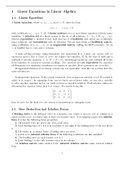Summary
Summary Linear Algebra Notes
- Institution
- Simon Fraser University (SFU )
These notes cover chapters 1, 2, 3, 4, the theory bases subsections in chapters 5 and 6, and then the first subsection in chapter 7. I have noted theorems from the book and elaborated on my understanding of the subject in a clear and concise manner. This is all rigorous theory, with little applicat...
[Show more]



